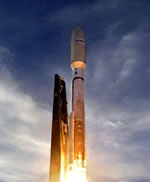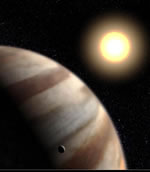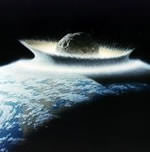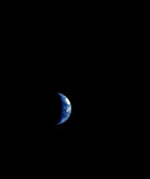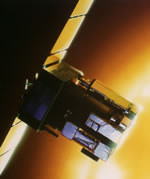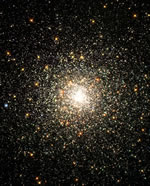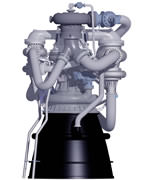
Image credit: NASA
NASA is working on several next-generation propulsion concepts that could help to push future exploration of the solar system, and one of the furthest along is the RS-84 kerosene-fueled rocket engine. The RS-84 is being designed by the Rocketdyne division of Boeing and it recently passed a detailed technical design review. The final, full-scale prototype engine should be ready for testing in 2007. Kerosene is more compact than traditional hydrogen fuel, saving launch weight, and it’s much safer to handle.
The kerosene-fueled RS-84 engine, one of several technologies competing to power NASA’s next generation of launch vehicles, has successfully completed its preliminary design review.
The RS-84 is a reusable, liquid booster engine that will deliver a thrust level of 1 million pounds of force. The design of the prototype engine is being developed by the Rocketdyne Propulsion & Power Division of the Boeing Company, in Canoga Park, Calif., for NASA’s Next Generation Launch Technology Program.
The program, part of NASA’s Space Launch Initiative, seeks to develop key space launch technologies ? engines and propulsion systems, hardware and integrated launch systems ? that will provide the foundation for America’s future space fleet.
The preliminary design review is a lengthy technical analysis that evaluates engine design according to stringent system requirements. The review ensures development is on target to meet Next Generation Launch Technology program goals: improved safety, reliability and cost. The review is conducted when the engine design is approximately 50 percent complete and engine drawings are approximately 10 percent complete.
“We’ve cleared our first major hurdle and the foundation is set for ensuring delivery of a safe, cost effective engine that will meet the next-generation launch requirements of NASA and the Department of Defense,” said Danny Davis, project manager for the RS-84 project at NASA’s Marshall Space Flight Center in Huntsville, Ala.
“We have a highly experienced team working on this unique design challenge,” Davis added. “I am very proud of the creativity offered by Rocketdyne, and of the thorough, constructive analysis provided by NASA’s insight team.”
The design team’s next major program milestone is the “40k” preburner test, a series of test-firings of a nearly full-scale preburner yielding 40,000 pounds of thrust. The test series, which will be conducted at NASA’s Stennis Space Center in Bay St. Louis, Miss., is scheduled to be completed in September. The final RS-84 prototype is expected to begin full-scale test firing by the end of 2007.
The RS-84 is one of two competing efforts now under way to develop an alternative to conventional, hydrogen-fueled engine technologies. The RS-84 is a reusable, staged combustion rocket engine fueled by kerosene ? a relatively low-maintenance fuel with high performance and high density, meaning it takes less fuel-tank volume to permit greater propulsive force than other technologies. That benefit translates to more compact engine systems, easier fuel handling and loading on the ground, and shorter turnaround time between launches. All these gains, in turn, reduce the overall cost of launch operations, making routine space flight cheaper and more attractive to commercial enterprises.
“No engine yet conceived meets the expectations of high reliability, high reusability mission life and responsiveness that is part of the RS-84 design,” Davis said. “Our design incorporates the latest in materials development, advanced software to monitor and predict problems, and lessons learned from past engine technology efforts.”
“The RS-84 preliminary design was shown to satisfy NASA’s goals, supporting an order of magnitude improvement in safety/reliability and operating cost,” said Roger Campbell, deputy program manager of Boeing Rocketdyne’s RS-84 engine team.
NASA’s Next Generation Launch Technology Program is developing and demonstrating innovative technologies in the areas of propulsion, systems integration and launch operations. The work of the program is intended to yield complete, next-generation space transportation systems that will provide low-cost space access and reinvigorate the U.S. space launch market, enabling stronger competition with international space agencies and private commercial entities, enabling stronger domestic and international competition.
Original Source: NASA News Release

